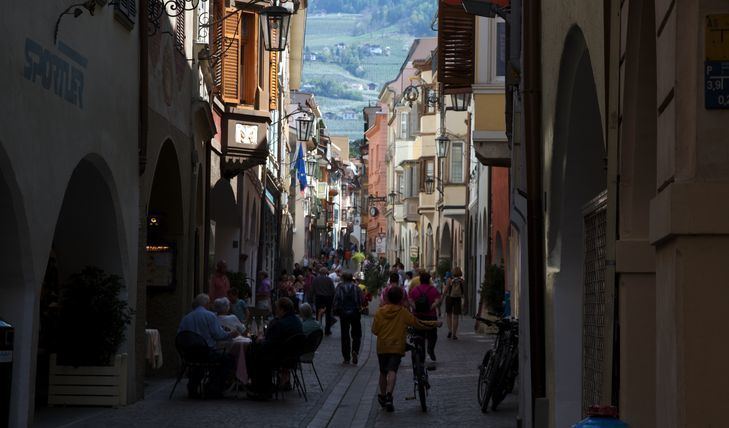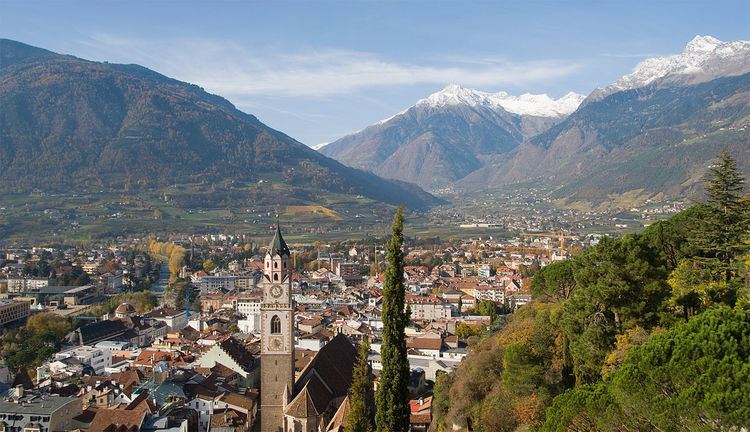Country Area 26 km2 Mayor Gunther Januth | ||
 | ||
Points of interest Gardens of Trauttmansdorff Castle, Passer, Vigiljoch, Ifinger | ||
Region Trentino-Alto Adige/Sudtirol | ||
Map of Merano
Merano ([meˈraːno] ) or Meran ( [merˈaˑn]) is a town and comune in South Tyrol, northern Italy. Generally best known for its spa resorts, it is located within a basin, surrounded by mountains standing up to 3,335 metres (10,942 feet) above sea level, at the entrance to the Passeier Valley and the Vinschgau.
Contents
- Map of Merano
- Italy merano naturno dolce vita hotels part2 travel
- Merano travel
- Place name
- Origin
- Coat of arms
- Main sights
- Food
- Notable people
- Tourism
- Linguistic distribution
- Twin towns and sister cities
- Sport
- References

In the past, the town has been a popular place of residence for several scientists, literary people, and artists, including Franz Kafka, Ezra Pound, Paul Lazarsfeld, and also Empress Elisabeth of Austria, who appreciated its mild climate.
Italy merano naturno dolce vita hotels part2 travel
Merano travel
Place-name

Meran is the German name for the town; Merano is the Italian name. Both are used in English. The Ladin form of the name is Maran. The official name of the municipality (comune) is Stadtgemeinde Meran in German and Comune di Merano in Italian (both are in official use).
In 17th-century Latin, the town was called Meranum. Other archaic names are Mairania (from 857 AD) and an der Meran (from the 15th century).
Origin
The area has been inhabited since the 3rd millennium BC, as shown by the presence of menhirs and other findings. The story of the city proper began in 15 BC when the Romans occupied the Adige valley founding a road station, Statio Maiensis.
The settlement was first mentioned in an 857 deed as Mairania. The Counts at Castle Tyrol elevated Meran to the status of a city during the 13th century and made it the capital of their County of Tyrol. After the county had been handed over to the Habsburg dynasty in 1363 upon the abdication of Margaret, Countess of Tyrol, in 1420, Duke Friedrich IV of Austria moved the Tyrolean court to Innsbruck. Though Meran remained the official capital until 1848, it subsequently lost its predominant position and almost all its importance as an economic hub across the roads connecting Italy and Germany. The important mint was also moved to Hall in 1477.
The Tyrolean Rebellion of 1809 against the French occupation drew attention again to Meran. In that year, on the Küchelberg above the city, a peasants' army eked out a victory against the united French and Bavarian forces, before their revolt was finally crushed. After World War I, under the Treaty of Saint-Germain-en-Laye Meran became part of the Kingdom of Italy with the rest of the southern part of the former Cisleithanian crown land of Tyrol.
On 12 April 2010, a train bound for Merano was hit by a mudslide 30 kilometres (19 miles) from the city between the villages of Latsch and Kastelbell. The resulting train derailment killed 9 people and injured 28; 7 of those seriously.
Coat of arms
The town's coat of arms depicts the red Tyrolean eagle sitting on a wall with four pieces of Ghibelline battlements and three arches that symbolize the city. The arms is known from 14th century and the oldest seal dates from 1353, while the coloured one since 1390. In a 1759 image, the eagle is represented with a crown and a green wreath of honour. After World War I and the annexation of the town from Austria-Hungary to Italy was a new coat of arms given in 1928, which looked similar to the old one, but with five parts of the battlements and the arches with the gates opened on a lawn of shamrock. A mural crown was placed above the shield. The five parts of the battlement represented the districts of Untermais, Meran (old town), Obermais, and Gratsch and Hafling, which were incorporated into the town by the Italian fascists. After World War II, Hafling became independent again and the historical coat of arms was restored.
Main sights
Among the town's landmarks are the medieval city gates such as the Vinschgauer Tor, Passeirer Tor, and the Bozener Tor. Also belonging to the fortifications is the medieval Ortenstein tower, popularly called Pulverturm (lit. "powder tower").
The main churches are the Gothic St. Nicholas' Church and the St. Barbara's Chapel, both dating to the 15th century. Also dating to this period is the Princely Castle (Landesfürstliche Burg), which was a residence of Archduke Sigismund of Austria.
The Steinerner Steg stone bridge crosses the Passer river and dates to the 17th century.
The town saw further development as it became increasingly popular as a spa resort, especially after Empress Elisabeth of Austria started visiting. Dating from the 19th century are civic theatre, the Kurhaus and the Empress Elisabeth Park. Also famous are the arched Wandelhalle promenades along the river.
After the annexation of the town to Italy in 1919, the Fascist authorities constructed the new town hall in the 1920s.
Outside the town is Trauttmansdorff Castle and its gardens. Also located there is the Museum of Tourism, which was opened in the spring of 2003 and shows the historical development of tourism in the province. Tirol Castle is also close-by.
Food
The area is well known for its wines, both white and red, and vineyards extend right into the town. The local wine, Meraner Leiten (Meranese di collina), is a light red wine, best drunk young. There are also extensive orchards, and apples are exported throughout Europe. The Forst Brewery on the edge of the town produces a popular range of beers, sold throughout northern Italy.
Notable people
Tourism
Merano is a popular tourist destination especially for Germans and Italians. In summer, there are concerts on the promenade almost daily, and there are fine walks around the town and in the surrounding hills, not least "Meran 2000", where there is also skiing in winter.
Linguistic distribution
According to the 2011 census, 50.47% of the resident population spoke German as mother language, 49.06% Italian, and 0.47% Ladin.
Twin towns and sister cities
The twin towns and sister cities are:
Sport
A chess opening, the Meran Variation of the Semi-Slav Defense, is named after the town, from its successful use by Akiba Rubinstein against Ernst Grünfeld during a tournament held in the town in 1924. In 1981, the World Chess Championship match between Anatoly Karpov and Victor Korchnoi was held in Meran. The first act of the musical Chess also has a world chess championship match set in Meran, and features a song entitled "Merano", which includes the line, "rosy-cheeked Merano, flourishing to a fault".
The city's handball team is one of the most successful in Italy, winner of the scudetto in 2005. The ice hockey team won two national championships, but it is currently playing in the Second Division (A2 series).
Each September, the Gran Premio Merano takes place in the Maia Racecourse; this is the most famous Italian Steeplechase.
Merano hosted the 1953, 1971 and 1983 ICF Canoe Slalom World Championships. This is where the well known 'Merano' move was created due to a tricky upstream gate. This move is now used and well known by many slalom paddlers globally.
